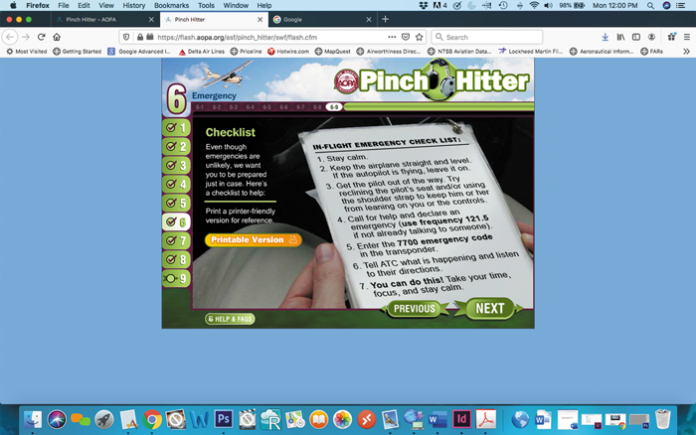It’s one of the things we macho pilots don’t like to talk about—incapacitation. We grouse about taking FAA medical exams or complying with BasicMed. Hey, we’re way to cool to worry about keeling over while motoring through the skies with our loved ones aboard.
The good news is that pilot incapacitation shows up as the cause of fewer than 1 percent of general aviation accidents—so the odds are good. The bad news is that incapacitation is generally tied to age and the average age of pilots is increasing—the goods are getting increasingly odd.
The worse news is that, from what we found in our research, those who ride along with their significant other pilots know that there is some risk of incapacitation and it scares them at some level. Those non-pilots are anything but dumb. They are smart people who have stayed alive and healthy because they have successfully navigated what life has thrown at them and they’d like to find a way to reduce the risk that they’ll die if their pilot partner passes out or on while they are flying together.
Put yourself in your partner’s place: You can’t fly the airplane. It goes fast a long way above the ground. All that is between you and minutes of sheer terror prior to violent impact is a guy (yes, guy, 94% of pilots are guys) who isn’t in the best of physical condition and gets winded climbing the stairs. Would you fly with you? You’re right, that woman sitting to your right in the Archer is brave beyond words.
EMERGENCY TRAINING
For reasons lost in the fog of aviation past, courses aimed at teaching spouses/partners/significant others to land an airplane after the pilot became incapacitated acquired the name “pinch hitter.” We’ll use that name to describe a course that is focused on training a non-pilot to fly an airplane we’ll enough to make a landing that is survivable.
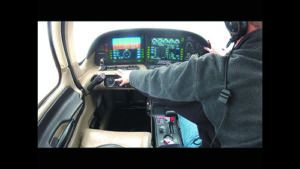
A pinch hitter course is not the more involved “flying companion” course. While we like those courses, they go into more detail and aim to turn a flying companion into an active flight crew member. Such courses are beyond the scope of this article.
WHAT’S OUT THERE?
We were interested to note that pinch hitter courses are offered all over the country by seemingly the smallest and the largest flight training organizations.
At the high end, SIMCOM (www.simulator.com) offers a “Pinch Hitter TM option” at its Orlando and Scottsdale training locations. SIMCOM’s website states that: “By attending the same piston or turboprop course with the primary pilot, the non-flying companion will experience the same classroom and simulator training as the primary pilot but at a 75% discount off the regular price.”
One of our readers reported that his wife had taken advantage of this offer and attended class and simulator training with him for their family Pilatus PC-12. His wife had been a white-knuckle flyer, but the SIMCOM course changed all that. She went on to acquire a number of pilot ratings, accumulated over 1000 hours of flight time and now flies the family PC-12 as pilot in command.
At a less rarified height, we looked at offerings by national flight schools, local FBOs and flying clubs. We saw prices ranging from $500 (with airplane) to $5000 (in a complex airplane). We were frustrated with how many providers did not publish prices, but were pleased to see that many did publish at least a rudimentary syllabus. The training courses all included ground school, generally from two to five hours, and flight time—two to 10 hours.
FAMILY AIRPLANE
It appeared to us as we worked on this article that most pinch hitter candidates are seeking training in the family airplane. That meant that the cost was simply for the CFI’s time. We think that a total of eight hours of dual instruction—split about half and half between ground and inflight instruction—is a good working number for an effective pinch hitter course.
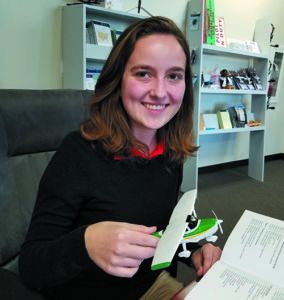
As an aside, we’ve taught pinch hitter classes and we spoke with other instructors who have done so as we prepared this article. All noted that they enjoyed working with pinch hitter students because they were invariably bright and very motivated to learn. However, they generally made it clear that they were motivated to learn the stuff that was relevant to getting the #%@#& airplane on the ground and nothing else. They were focused and didn’t want fluff. That meant that CFIs had to be on top of their game in explaining why something they were teaching was relevant, otherwise they risked being tuned out.
We had a number of CFIs and two flight school managers comment to us that pinch hitter training seemed to be more popular as we’ll as effective when the CFIs were women. The comments we got were that because most of the students are women, there seemed to be more of a peer-to-peer relation that fostered learning, something of value in a course that only lasts a few hours.
After a review of a number of syllabi at different schools and taking the AOPA (www.aopa.org) online Pinch Hitter TM course, we came to a number of conclusions as to what should be included in a pinch hitter course and syllabus. We’ll walk through them below.
PRELIMINARIES
Whether the plan is to attend an organized program through a flight school or contract with a local CFI for training there are some preliminaries that need to be taken care of before the student flies the airplane.
Assuming that the machine of choice will be the family airplane the first thing to do is to make sure that the pinch hitter pilot can sit in the right seat and comfortably see over the panel and reach the rudder pedals.
While that seems to be a no-brainer, the reality is that the high panels and lack of adjustment of front right seats in a lot of airplanes means that a lot of women (and men) who are of average height cannot see out of the airplane straight ahead in level flight.
That situation only gets worse as the airplane is pitched up during the landing sequence. As any instructor will tell you, the ability to see forward makes a huge difference in how fast a student learns to land. Even if the airplane involved is a tailwheel bird that is blind forward on the ground, being able to see forward to judge runway lineup on final and then flare height is vitally important when it comes to a newbie pilot pulling off a successful landing.
Find the seat position that is best for the student and then use cushions or pads as necessary to allow the pilot a seating position that generates a good view over the nose and the ability to move the rudders to the stop.
That may mean rudder extensions or some minor modification. Yes, get it done. Without them, you’re wasting time with the course. It may also be a good idea to tailor a set of cushions or pads as a number of vertically challenged professional pilots carry. Make sure that whatever is needed is always in the airplane.
INOP?
Fix the broken stuff.
You may be used to and able to deal with your out-of-rig airplane that requires constant right aileron input but it could be a killer if your wife has to step in and fly while dealing with being hit upside the head with the reality of you slumped over your shoulder harness, trying to get help over the radio, figure out where an airport is and—by the way—keep an out-of-rig airplane right side up. You’re not fixing the deferred maintenance items for you, you’re doing it for the most important person in your life.
PRIOR TO CLASS
Once the airplane is in shape and the student has a good seating position, she should take AOPA’s online pinch hitter course. It does an excellent job of introducing the relevant subjects in a fashion that makes sense. We particularly like the fact that it minimizes the use of jargon by using terms that are most likely to be understood by a non-pilot.
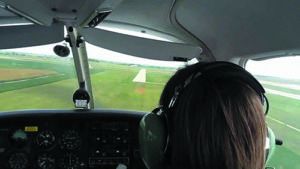
Finally, make sure the CFI involved has had a chance to get to know the specific systems and avionics of your airplane. At the most basic level, the CFI should have some flying time in the make and model—your insurance will probably require that—but she may not have dealt with mods you have such as tip tanks, or with the specific avionics suite. Give her some time with the POH. If need be, fly with her in your airplane so she can get a feel for its features.
TRAINING ENVIRONMENT
We recommend paying attention to the space used for the ground portion of the course, recognizing that the students, while motivated, are often quite nervous. In our experience and based on what CFIs and pinch hitter students told us, the ground school space should be comfortable, free of interruptions and free of threatening-looking items. Don’t have any post-crash photos lying around or crushed pieces of airplane or pretzeled props.
We’re not kidding. What the students seek to do is threatening enough to them, don’t add to the problem.
We also strongly recommend that no pilots be allowed in the training sessions—especially spouses. We heard too many stories of pilots adding their two cents to what the instructor was teaching, significantly interfering with the training and intimidating the students. Too often those pilots are doing nothing more than trying to show off their wide aeronautical knowledge. When called on the interruption they piously claim that they are “just trying to help.” The reality is that the nonflying spouse has heard it all—many times—from her aviator husband, doesn’t want to hear it again and may shut down.
The training atmosphere needs to be comfortable and safe and the CFI teaching needs to be able to go through the course in the manner she planned while sticking to the subjects pertinent to the course. She doesn’t need irrelevancies tossed in from spectators.
Based on our experience and research, it is our opinion that the ground training sessions can cover the subject in two two-hour sessions. We’ve seen flying clubs and FBOs hold the training sessions during evenings, often a week apart, so that it’s easier for people juggling work and kids to attend and get in some flying between the two ground sessions.
We also think that about four hours of “flight” time works well, although we recommend that, if possible, the first hour be in a flight simulator that has at least some motion capability. While the sim will not fly exactly like the airplane to be used and will probably have different avionics, it is an excellent nonthreatening environment in which to focus on the basics—control of the aircraft—without the distractions of noise, turbulence, weather and avoiding other aircraft.
GROUND SCHOOL
Have as many visual aids as possible for the ground sessions. The topics that we recommend be addressed are an overview of the airplane so either have an airplane right outside the door or large pictures showing the exterior, cockpit, avionics and autopilot, yoke/stick and rudder pedals and brakes, basic instruments and safety equipment such as fire extinguishers, restraint systems, door locks and, if installed, the ballistic recovery system.
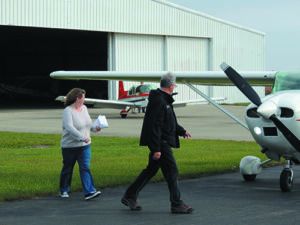
The next step is basics of flight, which calls for explaining the flight and engine controls and what they do. There is not much emphasis on the theory of flight—this is practical application. If I want to fly level, how do I do it? This section ties in the flight and engine controls with the concept of making the airplane go where the student wants it to go.
Next comes communications—who to call, how to speak on the radio and how to clearly declare that you have an emergency and need help—this is a time to be assertive and here’s how to do it.
Finally, there’s an explanation on how to find an airport and land on it (and how to shut off the engine).
Following that comes scenario training beginning with prevention: The pilot doesn’t seem to feel good, so encourage that Type A goal-achiever to divert and land. If prevention doesn’t work and the pilot becomes incapacitated, show how to secure the pilot away from the controls, how to keep calm and handle needed communications, including coding 7700 on the transponder. Then it’s time to work on use of installed automation, navigating to an airport, setting the airplane up to make a successful landing and getting stopped.
FLIGHT
The flight lessons mimic initial flight training but with an emphasis on the basics. Preflight and takeoff is taught, because the information is of value to the student (and she may detect a problem with the pilot before takeoff and can prevent an inflight incapacitation). More emphasis is placed on straight and level flight, climbs, descents and turns to a heading.
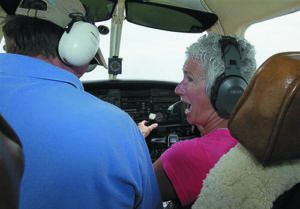
Radio communications are added, often with the instructor playing the role of controller. Use of installed automation is explained and practiced. Finally, the focus is on approaching an airport, configuring the airplane for landing and making the landing.
During ground and flight training we recommend that the instructor continually emphasize the student’s priorities when they suddenly become the pilot: 1. Fly the airplane. 2. Communicate. 3. Navigate. 4. Set up the approach. 5. Land the airplane and get it stopped.
CONCLUSION
We think that an effective pinch hitter course can be completed in eight hours, four on the ground and four in flight. The cost should be the cost of eight hours of CFI time and four hours of airplane (we prefer one hour in a motion-capable sim and three in an airplane) time.
Because aviation skills that are not practiced extinguish themselves, we also recommend that someone who has taken a pinch hitter course take recurrent training every year. We believe that can be accomplished in about half the time as the initial course. We think that setting aside a half a day with a trusted instructor to review the pinch hitter basics and make some landings will go a long way to allowing a safe ending to the unthinkable—inflight incapacitation of a pilot.
Having been involved in such classes, we encourage flight schools and flying clubs to organize and advertise pinch hitter courses on a regular basis. Our experience has been that it increases aircraft use as it increases spousal comfort with flying and it increases the overall safety level of operations at the organization. And, it has led to new student starts

